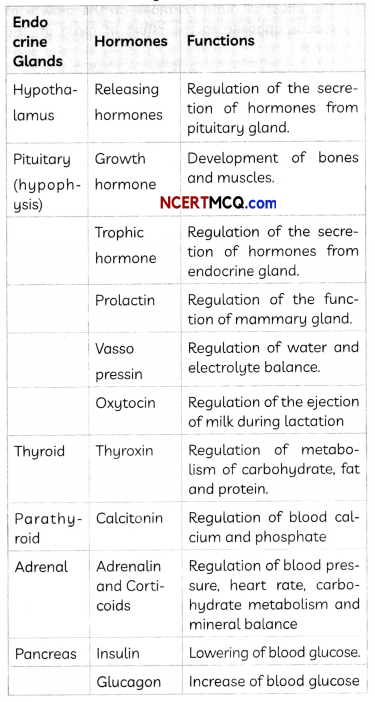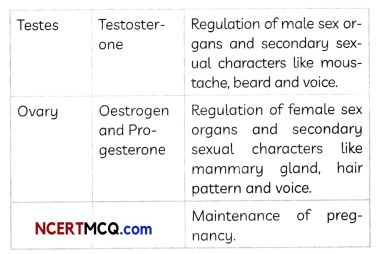Hormones in Animals
Hormones are chemical substances secreted in trace amounts by specialized tissues called endocrine glands.
Characteristics of Hormones
- They are specific chemical messengers.
- They are secreted by endocrine glands.
- They are poured directly into the blood and carried by blood circulation.
- They act on specific tissue/organs called target organs.
- Hormones are involved in the regulation of several functions.
Example: Adrenaline is secreted directly into the blood and carried to different parts of the body. The target organs or the specific issues on which it acts include the heart. As a result, the heart beats faster, resulting in a supply of more oxygen to our muscles.
The blood to the digestive system and skin is reduced due to the contraction of muscles around small arteries in these organs. This diverts the blood to our skeletal muscles. The breathing rate also increases because of the contractions of the diaphragm and the rib muscles. All these responses together enable the animal body to be ready to deal with the situation.
Endocrine or Hormonal System
This is another organ system that controls and coordinates various life processes.
Endocrine glands: The endocrine glands are also called ductless glands as they do not have ducts to pass their hormones. These glands are located in dif¬ferent parts of our body. Some endocrine glands perform dual functions.
- The pancreas secretes digestive enzymes and produce hormones insulin and glucagons.
- Testes and ovary produce gametes and also hormones Testosterone and oestrogen respectively.
![]()
A brief summary of Endocrine glands, their hormones, and their functions is given below:


Comparison of Nervous System and Endocrine system
| Nervous System | Endocrine System |
| 1. It is made of neurons or nerve cells | 1. Made of glands or secretory cells. |
| 2. Messages are transmitted in the form of electrical impulses | 2. Messages are trans-mitted in the form of chemicals called hormones |
| 3. Messages are transmitted along nerve fibres. | 3. Messages are transmitted through blood stream. |
| 4. Messages travel very fast. | 4. Messages travel more slowly |
| 5. The effect of message usually lasts for a very short while. | 5. The effect of message usually lasts longer. |
| 6. Nerve impulses are not specific in their action. | 6. Action of hormones is highly specific. |
Role of Iodine
Iodine is necessary for the thyroid gland to make the thyroxin hormone. Thyroxin regulates carbohydrate, protein and fat metabolism in the body so as to provide the best balance for growth. Iodine is essential for the synthesis of thyroxin. In case iodine is deficient in our diet, there is a possibility that we might suffer from goiter.
Role of Growth Hormone
Growth hormone is one of the hormones secreted by the pituitary. As its name indicates, growth hormone regulates growth and development of the body. If there is a deficiency of this hormone in childhood, it leads to dwarfism.
![]()
Role of Insulin
Insulin is a hormone which is produced by the pancreas and helps in regulating blood sugar levels. If it is not secreted in proper amounts, the sugar level in the blood rises causing many harmful effects.
Feedback Mechanism
If it is so important that hormones should be secreted in precise quantities, we need a mechanism through which this is done. The timing and amount of hor-mone released are regulated by feedback mecha-nisms. For example, if the sugar levels in blood rise, they are detected by the cells of the pancreas which respond by producing more insulin. As the blood sug-ar level falls, insulin secretion is reduced.
Example 1.
Compare and contrast nervous and hormonal mechanisms for control and coordination in animals.
Answer:
The differences between nervous and hormonal mechanisms for control and coordination in animals are listed below:
| Nervous System | Hormonal System |
| 1. Consists of nerves, brain and spinal cord | 1. Consists of endocrine glands and hormones |
| 2. Consists of impulses that travel along the nerve cells | 2. Consists of chemicals secreted by endocrine glands directly into the bloodstream |
| 3. Effect is observed immediately | 3. Effect is slow and delayed |
| 4. Does not affect growth | 4. May affect growth |
| 5. Response is short-lived | 5. Response usually lasts longer |